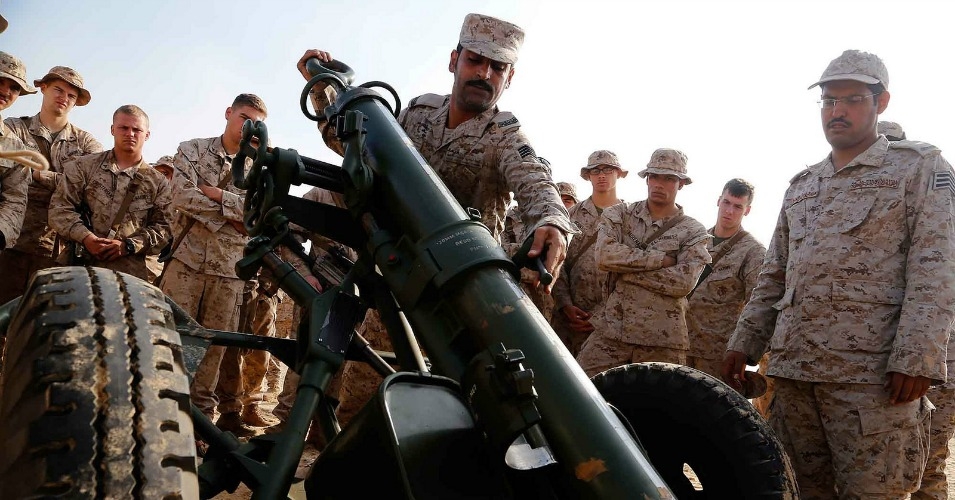Topping the list of those on the receiving end of these deals are Middle East allies, including Saudi Arabia
By Lauren McCauley, staff writer for Common Dreams. Published 2-22-2016

A joint weapons training exercise on how to operate an M67 120mm mortar system with the Royal Saudi Naval Forces and U.S. Marines. (U.S. Marine Corps photos by Gunnery Sgt. Rome M. Lazarus/Released)
The U.S. weapons industry continues to lead the world as the greatest supplier of major arms and munitions, according to an authoritative analysis, fueling the global violence and turmoil that has soared to unprecedented levels in recent years.
The report (pdf), put forth by the Stockholm International Peace Research Institute (SIPRI) on Monday, found that the U.S. continues to dominate the global arms trade, driving 33 percent of total exports between 2011 and 2015.
Meanwhile, the volume of the weapons sent to conflict areas from the United States has increased 27 percent compared to the period between 2006 and 2010, with an overall rise in the arms trade of 14 percent worldwide.
“As regional conflicts and tensions continue to mount, the [U.S.] remains the leading global arms supplier by a significant margin,” said Dr. Aude Fleurant, director of the SIPRI Arms and Military Expenditure Programme.
According to SIPRI, the U.S. has sold or donated major arms to at least 96 states in the past five years, which the report notes is a “significantly higher number of export destinations than any other supplier.” What’s more, another SIPRI analysis from December revealed that U.S.-based arms manufacturers are profiting heavily from these sales, reaping 54 percent of total global revenue.
Topping the list of those on the receiving end of these deals are a number of the United States’ Middle East allies. Saudi Arabia received 9.1 percent of the country’s total exports between 2011 and 2015, while United Arab Emirates and Turkey received 9.1 percent and 6.6 percent respectively.
Saudi Arabia, which is leading a U.S.-backed assault on Yemen, increased its imports 275 percent since the previous 5-year period, becoming the world’s second top global importer after India. The Gulf state is the United Kingdom’s top arms recipient, as well.
The report notes that the military assault on Yemen “was facilitated by high levels of arms imports” from western nations, despite growing concerns that the Saudi-led coalition has perpetrated a number of war crimes and contributed to high levels of civilian casualties.
“Although concerns have been raised in arms-supplying states over Saudi air attacks in Yemen,” the report states, “Saudi Arabia is expected to continue to receive large numbers of major arms from those states in the next five years. Arms on order include 150 combat aircraft and thousands of air-to-surface missiles and anti-tank missiles from the [U.S.], 14 combat aircraft from the UK and an undisclosed but large number of armoured vehicles from Canada with turrets from Belgium.”
The United States also continues to fortify Iraq with increased munitions, despite evidence that those weapons often end up in enemy’s hands. “Although the Islamic State captured or destroyed many weapons of the Iraqi armed forces in 2014,” SIPRI notes, “the flow of weapons to Iraq that started in 2003 continued in 2015.” According to the analysis, imports to Iraq grew 83 percent between 2006-10 and 2011-15.

